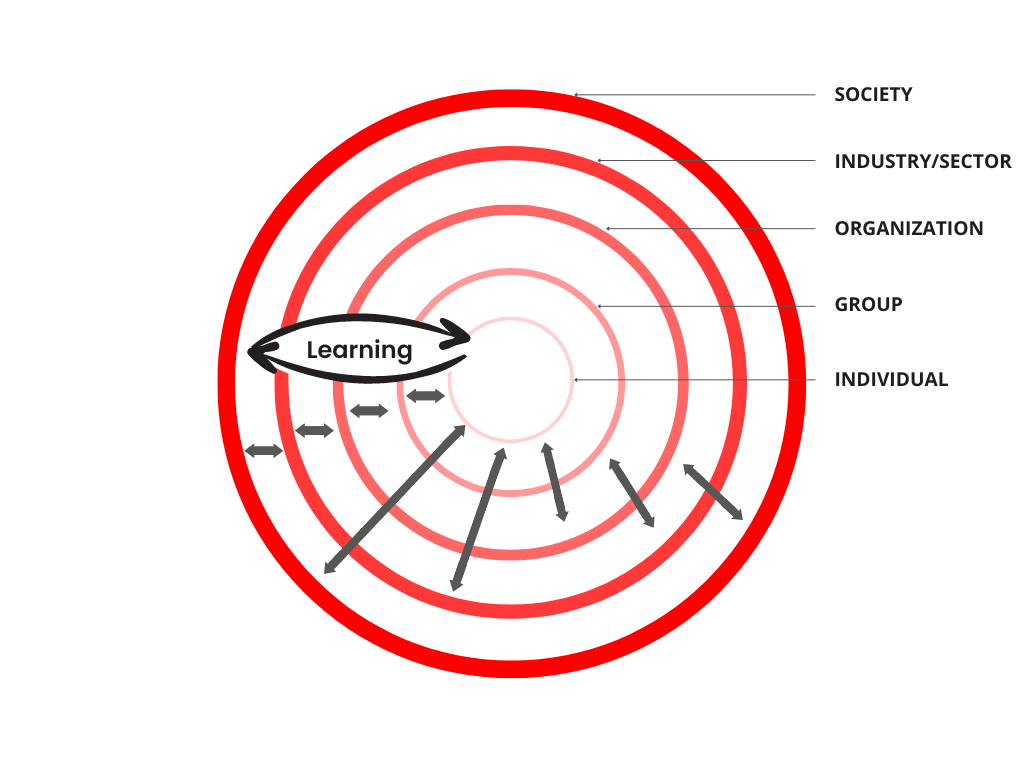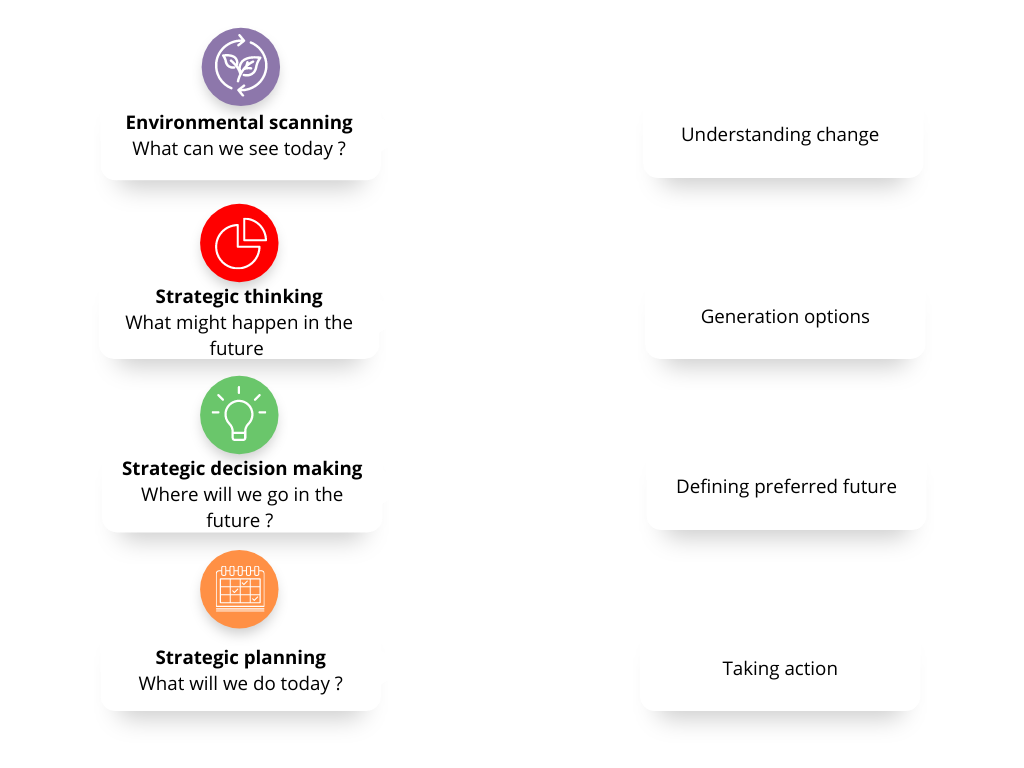Organisations are faced with complex decisions and increasing change
Nowadays, it is commonplace today to hear and say that the world is constantly changing. It is described as volatile, ambiguous, uncertain and complex (or ‘VUCA’ [1]). At the same time, in the professional sphere, we talk about ‘change management’ in organisations. But are we talking about the same type of ‘change’?
This question refers to the source of the changes experienced by organisations and, by extension, to that of planned change projects. The latter may, for example, concern work methods and tools, the organisational structure or the strategy of the organisation. These changes are always costly: in time, energy and resources for the actors involved. So, organisations do not change for the sake of change, they often do it to adapt, with the ultimate aim of remaining efficient, competitive and innovative.
But what do organisations adapt to when they initiate 'change projects'? And are organisations always adapting, 'catching up'? Can they anticipate change, or even initiate it?
A multitude of interconnected environments
First of all, it is important to remember that organisations, such as a company, an association or a hospital, can be described as complex. They are themselves situated in complex environments that fit together like Russian dolls: from the individual and the organisation (s)he is part of, to the planet itself and its ecosystems, to the financial markets or the education system, etc. All these elements are interconnected and therefore interact, which means that they do not just affect the individual but the organisation.
All these elements are interconnected and therefore interact, which means that they influence each other. In addition to the image of Russian dolls, one can think of a network. A classic effect of this interconnection is the butterfly effect, which has been widely used in fiction and the media.

ANTONACOPOULOU, Elena & CHIVA, Ricardo. (2005). Social Complex Evolving Systems: Implications for Organizational Learning.
It is therefore understandable that an event experienced at one of these levels may have an impact on the other levels. It will provoke reactions, changes, to the structure and actors in the other systems. And so, changes are very often the result of the fact that organisations are part of an environment that influences them. The Covid 19 pandemic or the war in Ukraine are good examples of this. In turn, organisations also influence their environment. For example, a company that discovers a revolutionary technology will have a major impact on its market. The B-Corps are based on this phenomenon of influence and feedback, having decided to become a force “for good” [2]
It is therefore impossible and illusory to reduce this complexity and the uncertainty that follows. There are simply too many actors, connections and relationships between them, not to mention the factors influencing these connections.
So we need to use a holistic vision to try to navigate this complexity. And try to develop reflexes in the face of inevitable and necessary change.
From forecast to foresight
The traditional approach to strategy emphasises the role of planning as the main driver of success. To do this, managers rely on observation of the past, such as historical patterns, extrapolation of trends, or statistics. On this basis, they are able to predict market developments and thus judiciously allocate their resources in order to optimise the company’s actions. This logic is very successful in an environment with little propensity for change. Indeed, we can accurately forecast something that has a high probability, such as the time it will take to get to work in the morning. A classic example is meteorologists, who use forecasting based on past and present data. However, when we want to envisage a future in which there is a high degree of uncertainty, it becomes much more difficult to forecast effectively. Today, anticipating and understanding change is becoming increasingly important, both to prevent risks and to detect opportunities. All of this is designed to ensure the sustainability of one’s organisation, as large companies are not only competing in the present, but also in the future.
How can the future help us in the present?
Strategic Foresight has been used since the end of the Second World War and is a widely accepted method for anticipating and understanding change in many governments and organisations. In the course of its application, the method has become increasingly robust and now allows us to systematically explore the possibilities available to us, using a systemic vision, which is essential in the context we have described.
Various tools are used for this purpose, including:
- Horizon scanning, which allows us to look for signals of change in the present and determine their potential future impact, and
- the identification of “Change drivers“, i.e. the potential changes that could be the most surprising and impactful.
Indeed, in order to anticipate changes it is important to collect the warning signs that a change dynamic is taking place. It is sometimes possible that a set of signals pointing in the same direction can already be observed in the environment. But it is also possible that these signs are isolated, that few people have heard of them, or only in a limited geographical sphere. These are called ‘weak’ signals [3]. From the collection and analysis of these signals, it is possible to see large dynamics of change taking shape that can have a strong impact on organisations.
To carry out this scanning effectively, it is necessary to map the environment and be able to answer the question: what is the organisation’s ecosystem and what signals from this ecosystem should we pay attention to in order to detect strategic changes? Horizon scanning can be conducted using a framework such as a PESTEL analysis for example.
“Organizations need not only to have the “map” of their territory, but also the “radar” that can place and guide them in turbulent, ambiguous, and uncertain environments”[4]
The Strategic Foresight scanning exercise has a double advantage. The first is to force organisations to observe their environments at a time when many decision-makers do not have the time to listen to their primary market. Secondly, it provides a framework and a proven methodology that moves away from ‘bar stool talk’ about the future, consisting of opinions and views. In particular, scanning allows us to take cognitive biases into account, especially the confirmation bias, which means that we only register what confirms our vision and our beliefs from the world and from the observation of our environment. In other words, these biases lead us to retain only the information that confirms that what we are doing is right, that our strategy is the right one. We need to overcome our biases in order to be able to identify changes that will, on the contrary, disrupt our ways of doing things and our organisations, or their sustainability. Using methods such as Strategic Foresight is essential if we want to broaden our field of vision, make the right connections, break out of our paradigms of reasoning and become interdisciplinary.
Another useful component of Strategic Foresight: defining scenarios
Working on the basis of scenarios means developing one or more stories and imaginary images of what the future might look like. Scenarios allow us to explore possible futures and learn from these projections. The benefit of this tool is also to test the impact of potential (usually extreme) changes to the system in which our organisation is situated, and will have an impact on our organisation, in order to decide what actions to take. For example, projecting the impact of a new consumption pattern in our market and testing the robustness of our current business model if this scenario were to occur. This refers to making decisions today, such as whether to invest in the development of a new technology or to develop a new product or service based on this possible future trend.

Ultimately, the aim of Strategic Foresight is exploration: to be open to a range of potential developments, opportunities and challenges that the future may bring. Strategic Foresight is based on the idea that there is not one single future whose contours can be anticipated with sufficient certainty, but several possible futures, desirable or not, to be prepared for [5] … and even built. Indeed, a strong idea behind the method is that from this exploration of the future, organisations can decide where they want to be in 5, 10, 15, 30 years time and decide what steps to take now to try to reach that goal. Through Strategic Foresight, one will imagine a desired future and think about the actions that need to be taken to achieve it, and without which that future will probably not happen.
Finally, the aim of Strategic Foresight is not only to anticipate changes, but also to develop our capacity to react quickly and effectively to changes that were previously impossible to anticipate. It is by repeating the exercise regularly, by integrating it into strategic processes, for example, that we strengthen the ability of teams to change, adapt and anticipate, and that of the organisation as a whole, in order to create a culture of change.
« Strategic Foresight allows us to activate our awareness about future change and increase our comfort to navigate every extreme condition of that change presented in the environment. »
Guy Loinger
Indeed, Strategic Foresight supports the adoption of enlightened leadership (360° vision of the current and future ecosystem), and employees’ ability to develop those skills[6] crucial for innovation.
Thus, at a time when sustainability issues occupy a growing part of the strategy of organisations and induce a systemic transformation that requires a long-term vision, Strategic Foresight offers the necessary tools to envision tomorrow, and to decide on the impact you want to have on the Future because: “Tomorrow, your companies, in their current state, may no longer exist” …[7]
Let us help you!
WANT TO RECEIVE OUR LATEST THOUGHT LEADERSHIP CONTENT?
Related posts
 Digital Transformation and Change Management: Lessons shared in an event hosted by Cebi and MindForest
Digital Transformation and Change Management: Lessons shared in an event hosted by Cebi and MindForest
 Can Engagement Help Reduce Absenteeism?
Can Engagement Help Reduce Absenteeism?
 Daring to Lead Positive Transformation: What If you explored a disruptive approach to Change with Appreciative Inquiry?
Daring to Lead Positive Transformation: What If you explored a disruptive approach to Change with Appreciative Inquiry?
 Have you Examined the Advantages of Working with Data Analytics yet?
Have you Examined the Advantages of Working with Data Analytics yet?
 Daring to Lead Positive Transformation: How can you implement and manage positive change with success?
Daring to Lead Positive Transformation: How can you implement and manage positive change with success?




